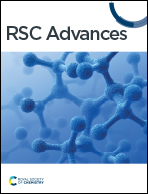A novel COOH–GO–COOH–MWNT/pDA/AuNPs based electrochemical aptasensor for detection of AFB1†
Abstract
Aflatoxin B1 (AFB1), one of the most common mycotoxins in food matrixes, has been identified as the most toxic contaminant with mutagenic, teratogenic, immunosuppressive, and carcinogenic effects. In this study, an electrochemical aptamer sensor was developed for the on-site detection of AFB1. Carboxylated graphene oxide (COOH–GO) and carboxylated multi-walled carbon nanotubes (COOH–MWNT) nanocomposites, dopamine polymers (pDA) and gold nanoparticles (AuNPs) were used to enhance the electrochemical activity and the biocompatibility of the screen-printed electrodes (SPE). Once AFB1 was captured by the aptamer immobilized on the electrode surface, the redox current of [Fe(CN)6]3−/4− decreased. Therefore, the binding of aptamer (Apt) and AFB1 can be reflected by the change of the peak current. The as-prepared sensor showed a wide detection range of 0.1 fg ml−1–100 pg ml−1 and a low detection limit of 15.16 ag ml−1. It is also simple and low-cost, which shows great potential in practical application.



 Please wait while we load your content...
Please wait while we load your content...